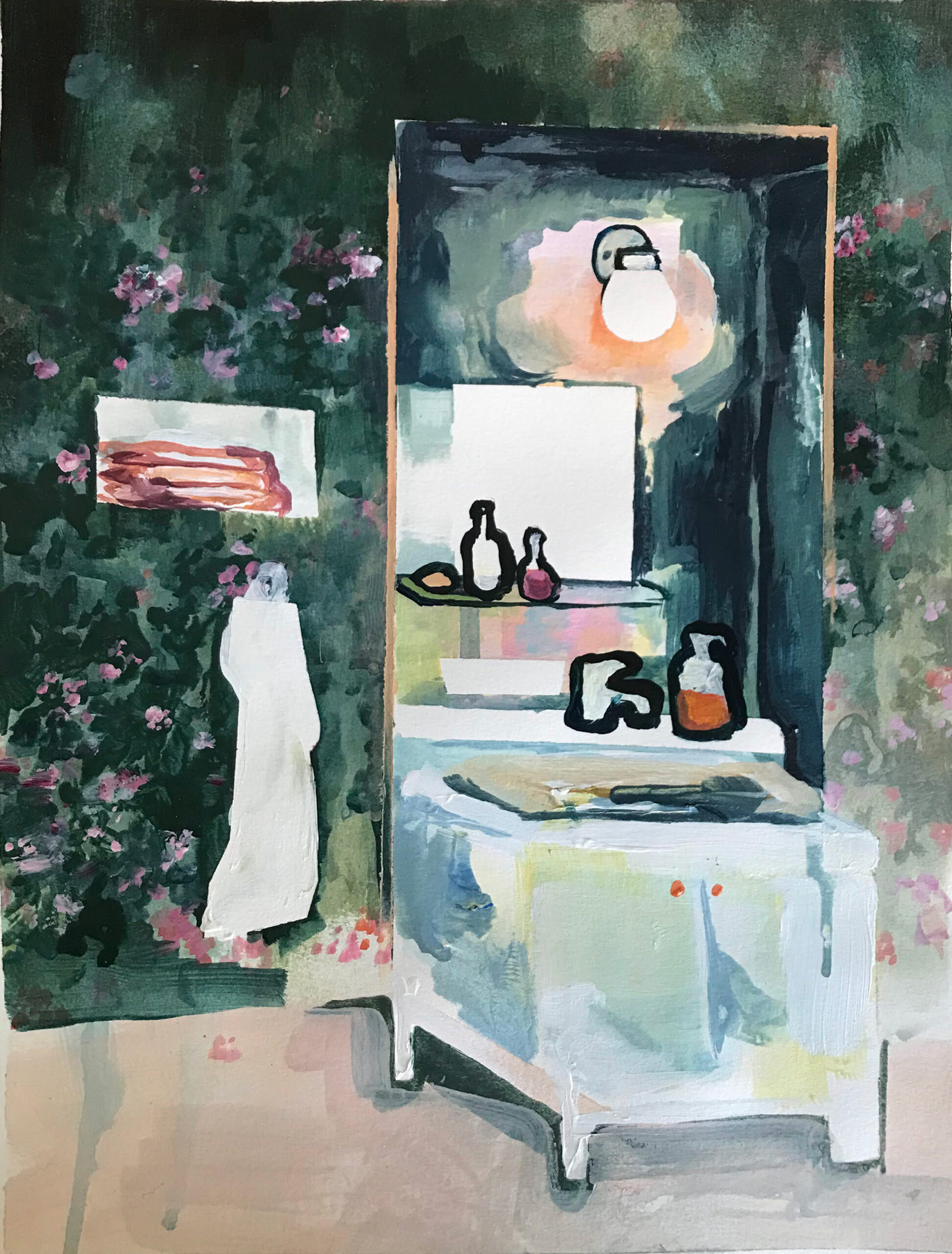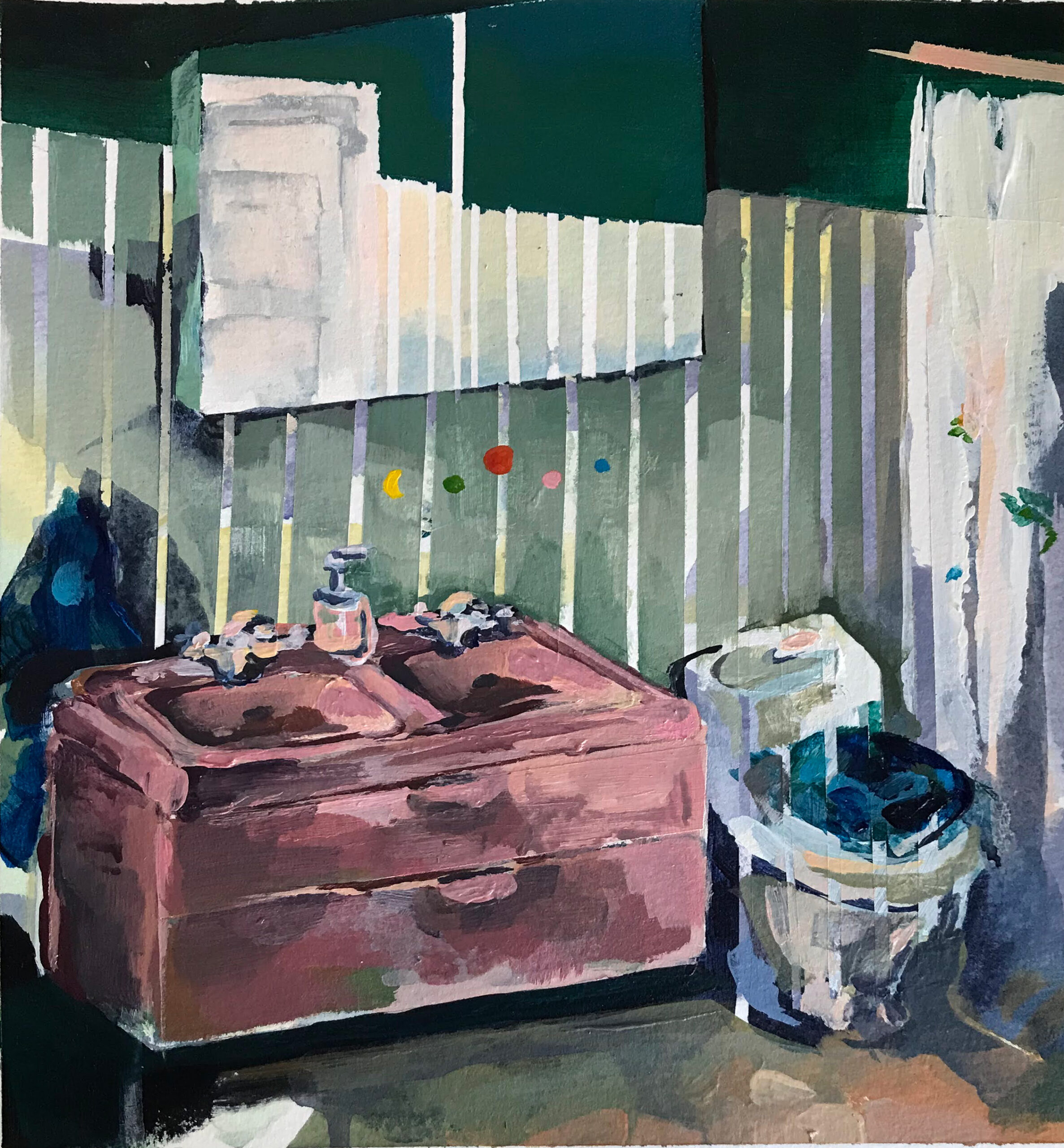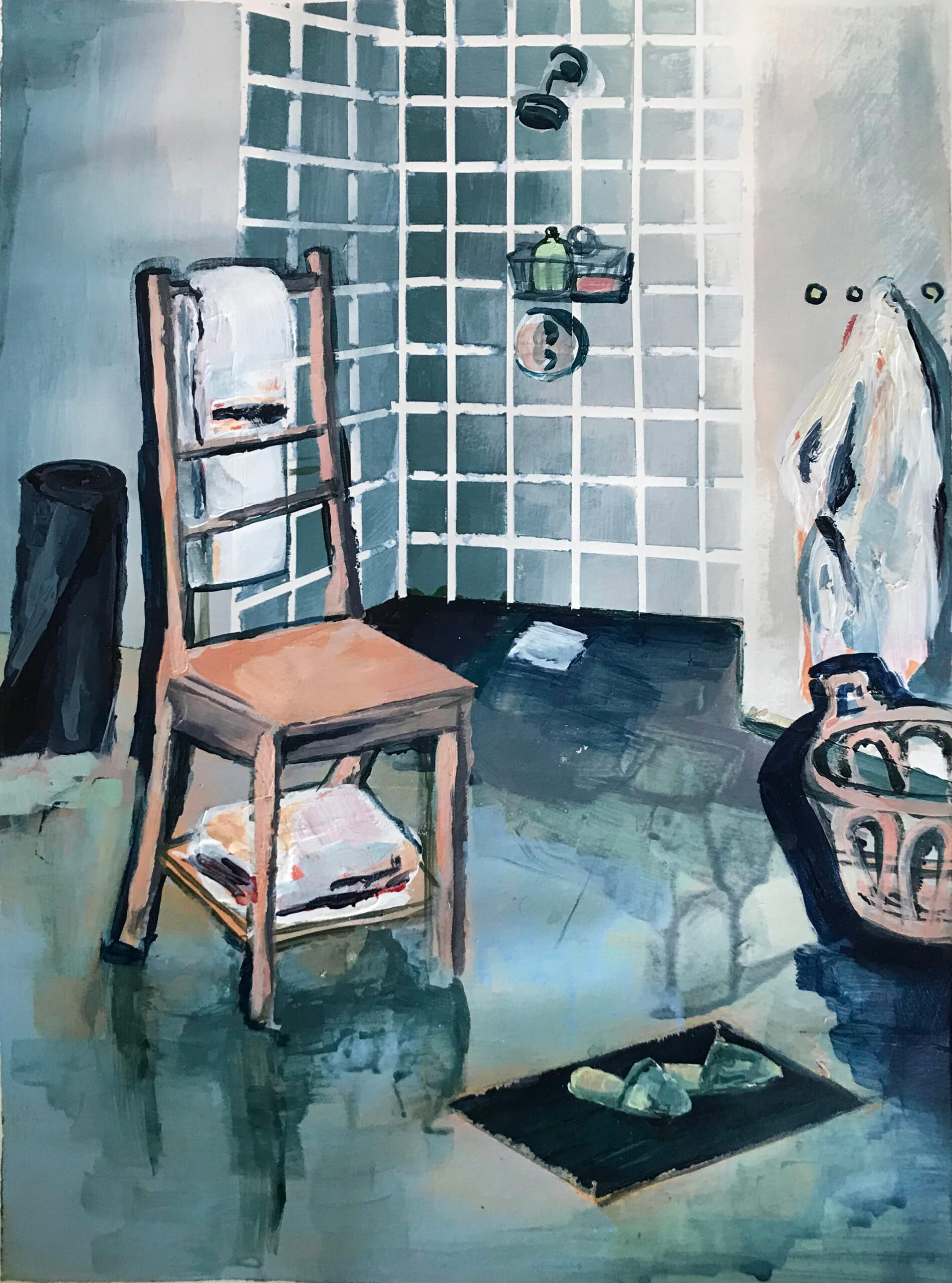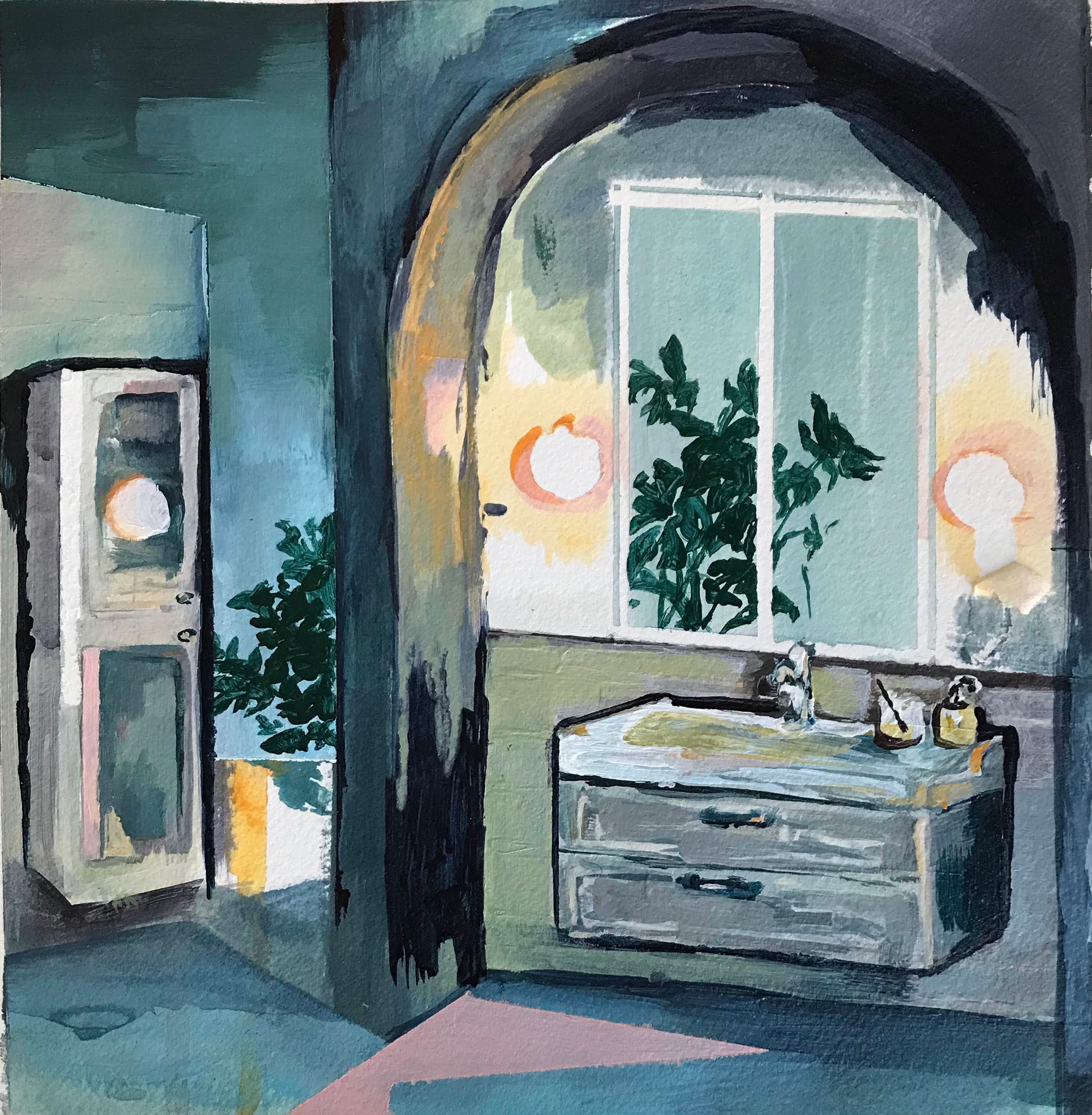This Will Work Better ❋ M. Gnanasihamany
This will work better if you stop trying
to imagine the remainder of the home.
What we have now are soft closing
features, full size, extendable drawers.
Walls and objects in need of reproduction
present themselves: the glow of vanity
bulbs conformed to traffic light arrangement.
Trust that the windows are elsewhere,
picture planes backed up in vinyl with a view.
Natural light is, like all things, standardized.
Off-screen, nourishing unlikely plant life
in the hard-working bathroom of neutral delights.
Here, a philodendron—pure composition.
Palm fronds thrive, housed behind the door.
Neither invention nor referent, orphaned signs
for the everyday speak in plastic. Oh, foolish friend,
those were never real flowers to start with,
their corruption is barely felt.
Thin lines lurk of violet around the basin edge; Good
phallic swoop of a door handle, good glow of the fluorescents.
lovely, inexpensive mirrors, packaged in sets of one.
GODMORGON / ODENSVIK $499 (faucets sold separately).
The air path is open, cleared for projection
as though, yes, this bathroom could be yours!
You are so clean it’s unnerving.
No reflection in the mirror, check.
You are a person with multiple brushes
for your face, clothes, and countertops.
Rainbow knobs reveal a crescent moon, shoved out
of The Reflection and into the wall. Artfully, you have allowed
an ugly object to remain (exempt from translation, check).
Finally, a toilet, after all those gentle double sinks.
GODMORGON again, and this one is designed to save water.
The interior of the cabinet contains: glass, terrycloth, yellow;
unintelligible, and a bell jar (empty, check);
waylaid for a circle to match other shapes.
Nearly futurist, all these leading doorways,
De Chirico archways (metaphysical attributes of passages
and floating heads like dreams or predictive texts).
Here, the philodendron returns.
Awful pink in the porcelain; it makes for a grim shit hole
instead of the more likely: an apartment
with investments to balance the building-it-
yourself and the polyester shower curtain.
Investment is both a dream and a waste of time
when attachment to ones things is anxious, lacking
in control. Not pictured: Storage box with lid,
$19.99, inherited location, accent piece.

Still, by now we could say things have gotten better.
The overhead directs: Rise and shine
with GODMORGON: quality, range, price;
another extraordinary Monday in the catalogic universe.
Strong teals, navy, precious peach.
Both darks and brights in wall paint imply occupation
under terms of ownership. Organize on your terms:
let your taste supercede the furniture.
We might call this an abstraction; the image
is by nature indiscreet, telegraphing means and ends
in service of modular superstructure, concomitant
production of a Good and private Morning.
Thank god this isn’t real, showering with a cold sight line
12-15 feet in front of you: an impossible shot.
A blank surface ready, but not requiring of anything
more. I miss the evidence of living.
The sink is a ghost. The towel is a ghost.
The faucet is clearly a drawing and not a vessel.
Reducing the individual to body without the collective,
no body to pursue its mode of inquiry
except for buying power, ornamentation, luck.
Attend to parallels in blank-slate design, cells
structure suburbs with a range of incomes
beginning with extraction and ending in debt.

Nothing made and nothing borrowed,
plastic, glass, and particle board melt from the air—
quick now, your busy hands will compose the final shot.
(no GODMORGON this time, the guest bathroom I am sure)
Early on, we pretended this was real life;
outside the bathroom there are two doors
one leading into the bedroom (pages 104-156)
and the other to the hallway (not pictured).
This leads to either more bedrooms or kitchens
or a functional and cost-efficient home office setup
disguised as a spare, although no one comes to visit
unless they're buying, testing the bounce.
We enter in the spring, and I see the basket in home goods.
“This is my basket!", I say, assuming
depiction is tantamount to ownership.
We exit through the check-out, and watch
all the people we failed to notice before,
opening drawers and standing fully clothed
in the many showers of our homes, twinning
with new soap dishes and dispensers.
You know where the light falls by now.
In the painting, folded towel like newsprint,
weight of body inside bathrobe: safe within
our blessed 600 square foot homestead.

___________________
This Will Work Better is an ekphrastic work of painting and poetry. The paintings are reproductions of pages from the IKEA 2020 catalog, specifically full-page promotional images for the IKEA bathroom collections. Painting from photography necessarily abstracts from the original image, allowing for a possibility of undoing or undermining the authority of the photographic image; the poem examines this potential process along with the paintings themselves, their source material within the IKEA catalog, and the commercial space of an IKEA floor room.
This Will Work Better is an exploration of the world interpolated by IKEA imagery. It operates on the prison abolitionist understanding that one population’s safety or freedom is contingent on another’s unsafety, their unfreedom. The clean and simple family homes and student apartments of the IKEA catalog can be looked at as evidence of one particular fantasy of economic and social freedom, implicating the existence of a group for whom this fantasy is unavailable. What norms surrounding private property, the family, race, and gender are reproduced by the void of the IKEA endless home? The IKEA bathroom is an especially interesting place for its utility; unlike a living room, study, or walk-in pantry, everywhere that there are people living there is a bathroom. IKEA offers the nation a national export; it reaffirms nationalism, creating the distinctness of culture by offering it a signature design aesthetic and then exporting it, rendered in affordable, modular, bits. Used IKEA products shuffle through Kijiji, Facebook Marketplace, and Buy-and-Trade groups, allowing for particular pieces—the BILLY bookcase, the LACK table—to become ubiquitous, taking on a degree of misplaced familiarity as our own furniture appears to have landed in other people’s homes. The DIY element of IKEA furniture allows for a potential obfuscation of the human investment that allows the company to offer the dressings of a home for less; labour and materials devoted to resource extraction, fabrication, transportation, and waste removal are what make cheap things possible. What work makes it possible to call a neutral space home?
___________________
M. Gnanasihamany is an artist and writer whose work explores the political world of pictures. Within their work in painting, poetry, critical arts writing, and curation, they examine the capacity for visual media to at once mirror and enforce the conditions of its own production through processes of dissemination, collection, and reproduction. Most recently, they co-curated The Equivalence of Alloyed Gold, a year-long experimental commissioning process hosted by Critical Distance Centre for Curators, and they are presently curating an online exhibition in collaboration with Free Lands Free Peoples, an Indigenous-led prison abolition group, and hosted by Latitude 53 Gallery, which will exhibit artworks and writing by current and formerly incarcerated people. M.’s written work can be found in Leste, Peripheral Review, Mood Magazine, SNAPline, and elsewhere; their mini-chapbook, Unconscious Method, was published by Ghost City Press in 2021. They are currently focused on a new research project critically examining the material implications of highly networked and reproduced images beginning with an exploration of visual media depicting sunsets. M. lives in Tio’tia:ke.

